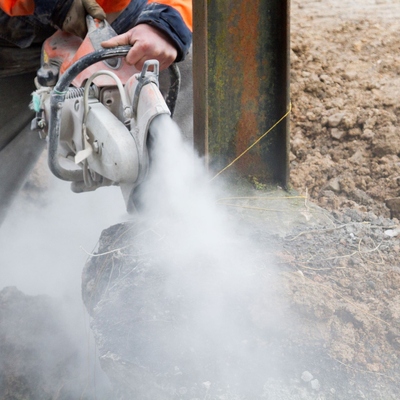How harmful is exposure to dust in the workplace?
In many industries workers can be exposed to high levels of dust, causing breathing problems that could lead to life threatening respiratory diseases. Most occupational lung diseases are caused by repeated, long-term exposure, but even a severe, single exposure to a hazardous agent can damage the lungs.
Disease that affects the lungs and other parts of the respiratory system due to occupational exposure are mostly related to dust inhalation and the deposition of inhaled particles in the lungs. The damage is dependent on the size, physical properties and chemical properties of the aerosol, frequency and duration of exposure, and an individual’s susceptibility to dust particles in the lungs.
Every year in the UK, about 12,000 people die from lung diseases which were linked to past exposures at work. In 2020/21, in comparison, 142 fatal injuries occurred at work. In other words, 99% of deaths caused by work can be attributed to ill health, and 1% to poor safety.
Key facts
Dust is a prevalent exposure at workplaces in various types of industries such as mining, foundries, chemical and food industries, stone working, and woodwork. While many industries expose workers to dust, not all dust is equally harmful. Excessive exposure to some types of dust has been linked to the development of particular health problems, such as lung cancer or asthma. Different forms of the same substance may present different hazards. A large piece of a solid may present a negligible hazard, but when ground into a dust it may become hazardous; wood and sandstone are obvious examples.
- Exposure to any dust in excessive amounts can create respiratory problems.
- The harmful effects of dust can vary, from skin irritation to lung cancer, depending on the composition of the dust and the type and degree of exposure.
- Dust is not always an obvious hazard because the particles which cause the most damage are often invisible to the naked eye and the health effects of exposure can take years to develop.
- Dust that can enter the nose and mouth during breathing is referred to as ‘total inhalable dust’. Some dust may consist of larger or heavier particles that tend to get trapped in the nose, mouth, throat or upper respiratory tract where they can cause damage.
- Dust particles that are small enough to be breathed into the lungs are called ‘respirable dusts’; these dusts can build up in the air spaces in the lungs and can lead to lung damage.
- The build up of any dust in the lungs could produce lung damage with inflammation and eventually fibrosis (scar tissue). This could lead to breathing impairment. These conditions usually develop slowly, so symptoms may not appear until severe irreversible changes have taken place.
- Some dusts are well known for their ability to produce serious lung diseases of this type, e.g. respirable crystalline silica (RCS) can cause silicosis and also lung cancer. Chronic effects of dust in the lungs are usually permanent and may be disabling, so prevention of the onset of disease should be given the highest priority.
- Certain dusts, e.g. dusts from grain, flour, wood, reactive dyes and proteolytic enzymes are respiratory sensitisers which can cause occupational asthma (attacks of coughing; wheezing and chest tightness), rhinitis (runny or stuffy nose) and extrinsic allergic alveolitis (symptoms can include fever, cough, worsening breathlessness and weight loss).
The following are the most common symptoms of lung diseases, regardless of the cause. However, each individual may experience symptoms differently. Symptoms may include:
- Coughing
- Shortness of breath
- Chest pain
- Chest tightness
- Abnormal breathing pattern
How can dust exposure be managed or reduced?
Reactec are collaborating with Trolex, a specialist in dust monitoring, to integrate their sensor technology into the Reactec eco-system to ease record management and reporting of dust monitoring.
Learn how Reactec can helpEstimated new cases of breathing or lung problems caused or made worse by exposure each year on average over the last three years.
Number of people dying from lung diseases which were linked to past exposures at work, each year in the UK
of all occupational mortality was attributable to disease, primarily, the result of work-related lung disease and cancer, attributed to past exposure to chemicals and dust at work
Useful Links
Legal obligations
If dust falls within the definition of a ‘substance hazardous to health’ then the requirements of COSHH (https://www.hse.gov.uk/coshh) will apply, including the need to assess the risk to workers and to ensure exposure is prevented or adequately controlled. Dust will be a ‘substance hazardous to health’ for the purposes of COSHH if it is a substance:
- which is listed in Table 3.2 of part 3 of Annex VI of the CLP Regulation (https://echa.europa.eu/regulations/clp/legislation); and
- for which an indication of danger specified for the substance is very toxic, toxic, harmful, corrosive or irritant; or
- if it is a substance to which a workplace exposure limit (WEL) applies.
If not falling within any of the above categories, paragraph (d) of the definition of ‘substance hazardous to health’ in regulation 2 of COSHH states that any dust when present in the workplace at a concentration in air equal to or greater than 10 mg/m3 of inhalable dust or 4 mg/m3 of respirable (as a time-weighted average over an 8-hour period) is considered to be a substance hazardous to health.
Workplace exposure limits (WELs)
Many substances that can create dust have been given a WEL under COSHH. WELs are British occupational exposure limits and are set in order to help protect the health of workers. WELs are concentrations of hazardous substances in the air, averaged over a specified period of time, referred to as a time-weighted average (TWA). Two time periods are generally used:
- long-term (8 hours); and
- short-term (15 minutes)
Short-term exposure limits (STELs) are set to help prevent effects such as eye irritation, which may occur following exposure for a few minutes.
Not all dusty materials have a WEL; however, the lack of a limit does not mean that the substance is safe. Where dusts do not have a WEL but there is evidence of potential hazards to health, employers should consider setting their own in-house standards, taking into account good control practice.
Where dust contains components which have their own WELs, compliance with all of the relevant individual limits is required.
Many thousands of substances are used at work but only about 500 substances have Workplace Exposure Limits (WELs) listed in EH40 workplace exposure limits
https://www.hse.gov.uk/pubns/priced/eh40.pdf
How do I know if exposures are below the WEL?
You can only do this by monitoring. This means measuring the substance in the air that the worker breathes while the task is underway.
COSHH assessment
The COSHH Regulations require employers to assess the risk to their employees, and to prevent or adequately control the exposure of employees to substances hazardous to health. You should:
- make a suitable and sufficient assessment of the risks to health from the dust(s) concerned and of the steps that need to be taken to meet the requirements of COSHH; and
- implement those steps before the work begins.
Sometimes air sampling may be needed to find out the level of exposure. These measurements should be made under normal working conditions and may be supported by the observation of light scatter by using a dust lamp to detect any less obvious escapes of very fine dust.
A risk assessment should include:
- an assessment of the risks to health from dust which should include: – information on the hazardous nature of the dust; – the type of exposure (inhalation, dermal or ingestion); – how the exposure occurs;
- details of the controls to be used; and
- if appropriate, arrangements for emergency procedures.
If you employ five or more people, the significant findings of the assessment must be written down, along with the steps you are taking to prevent or control exposure.




